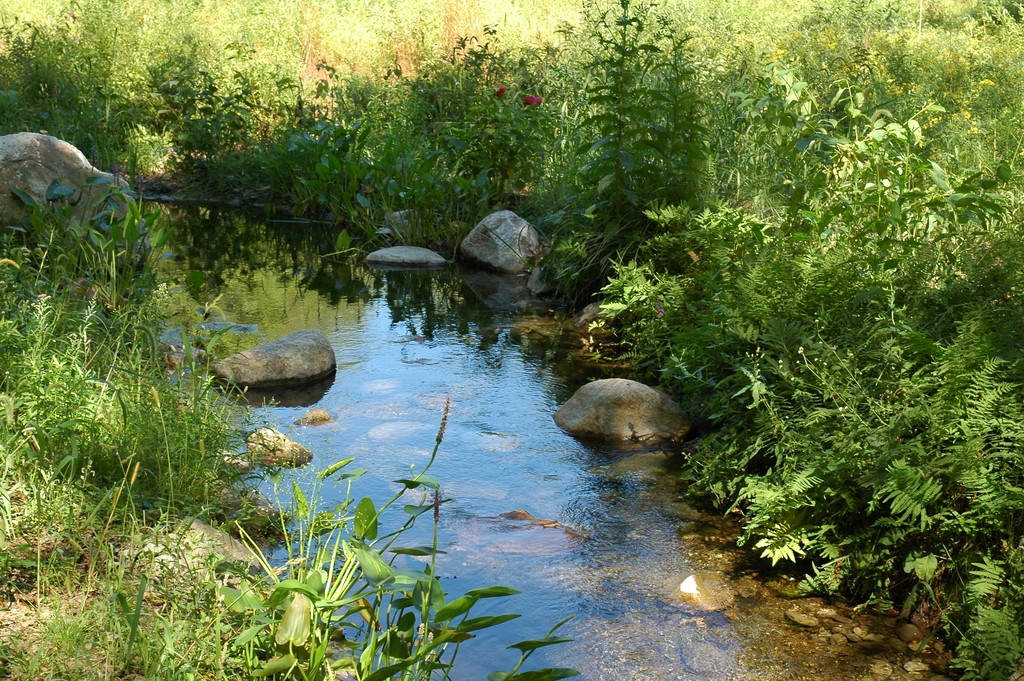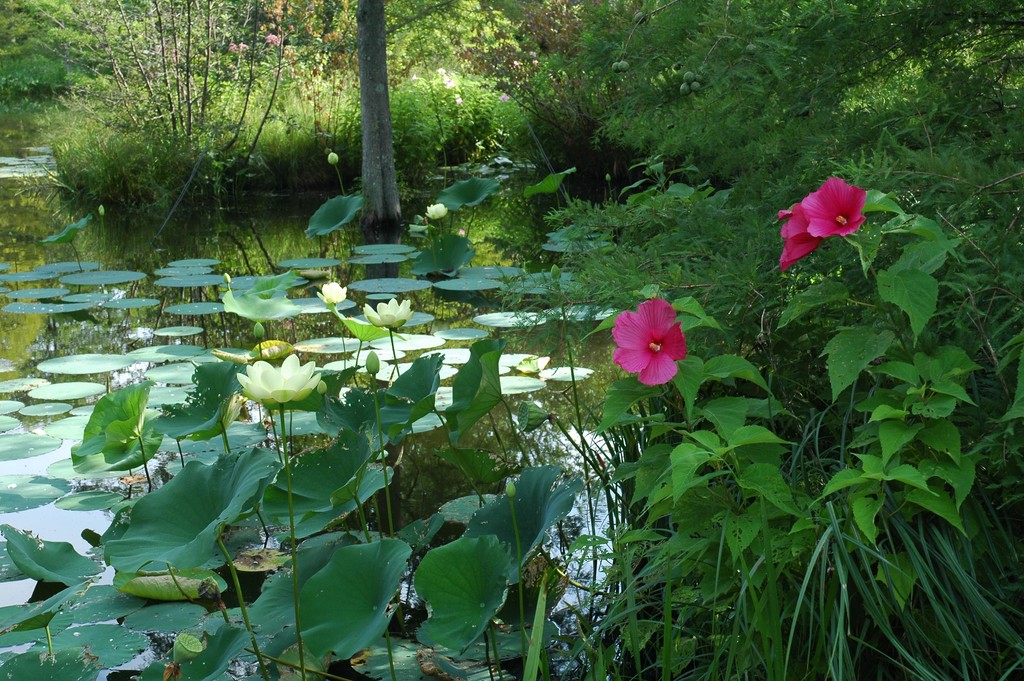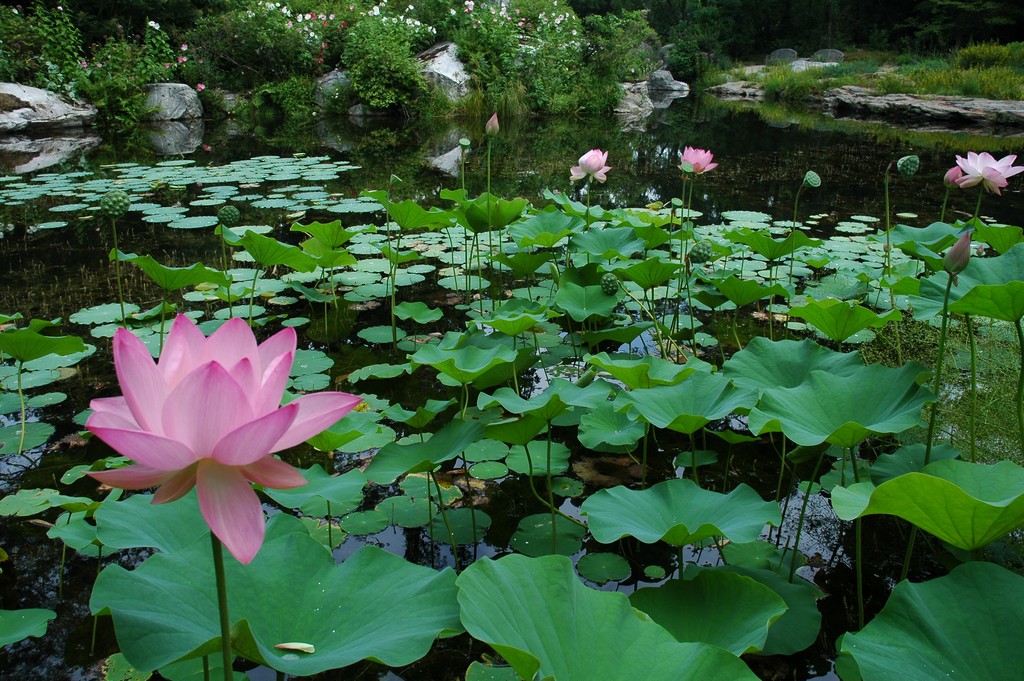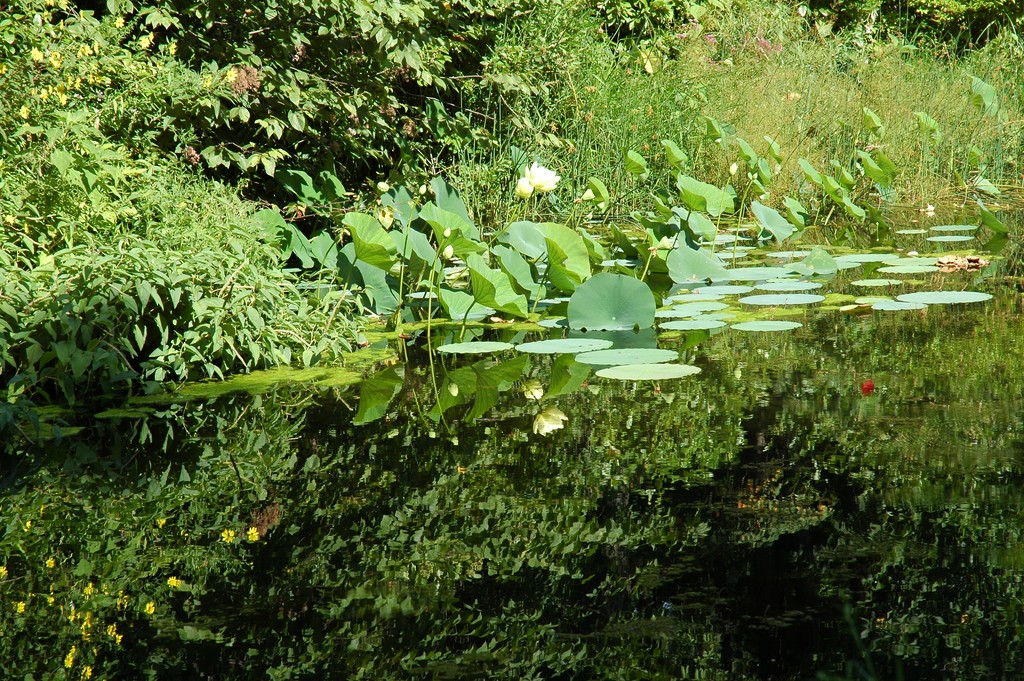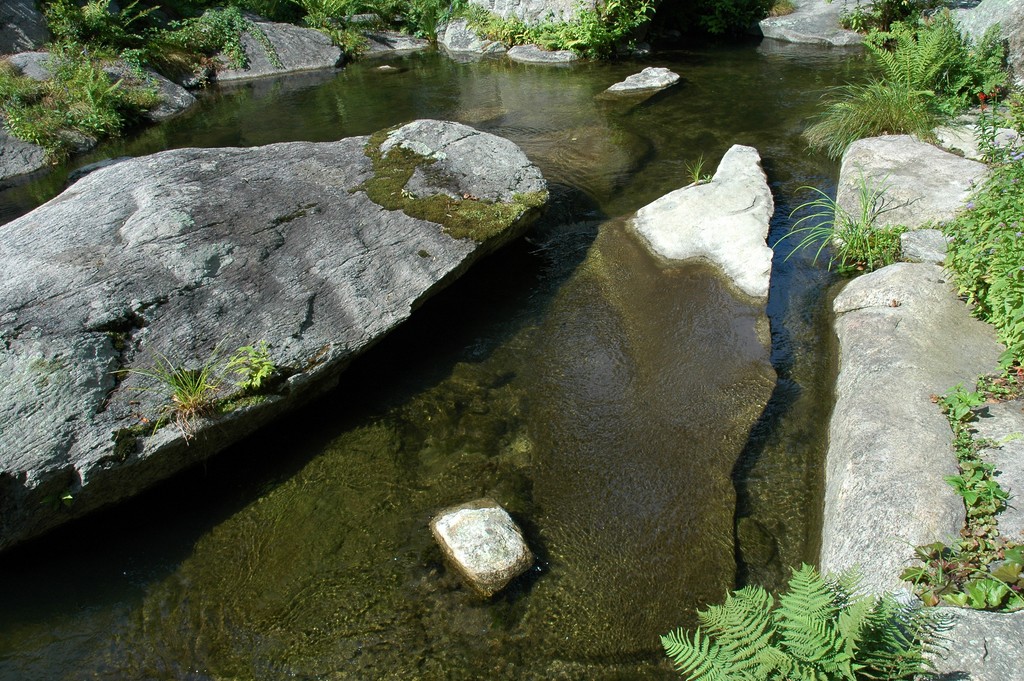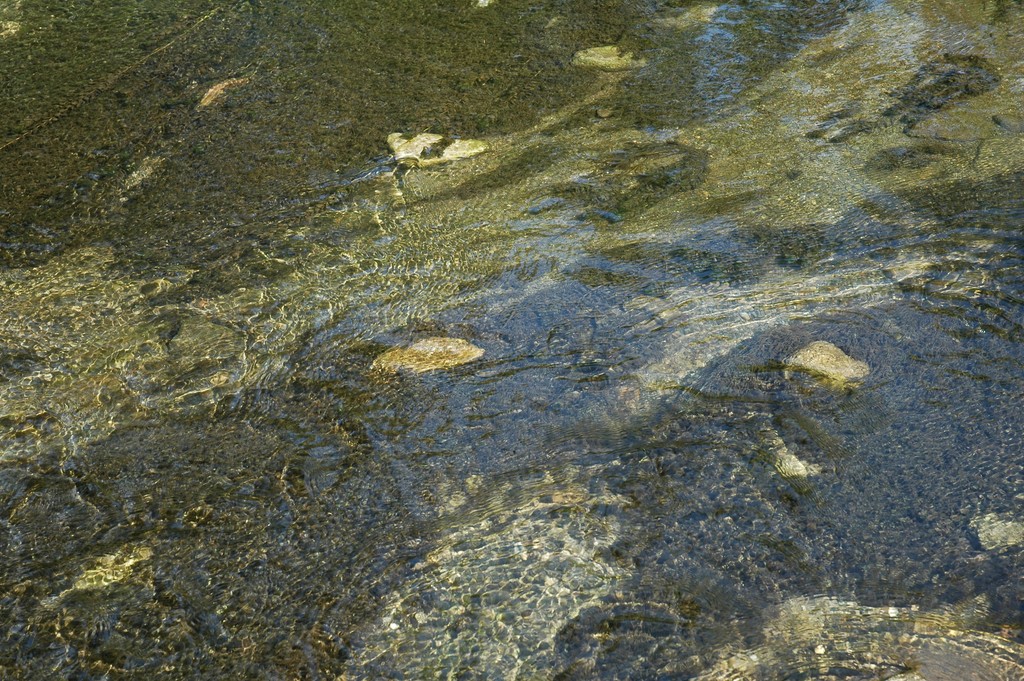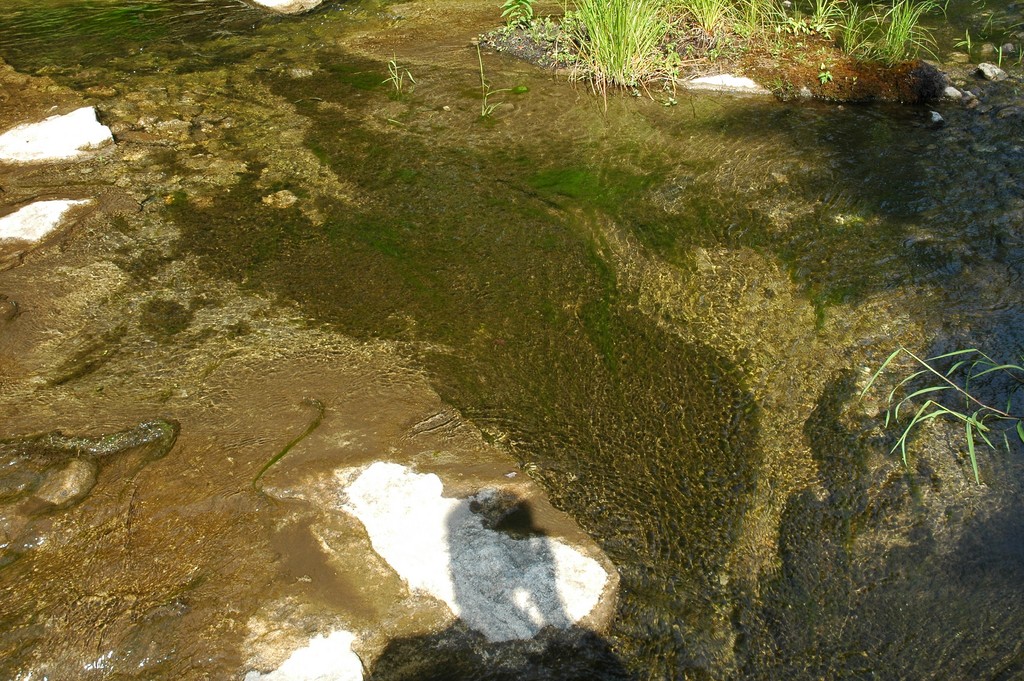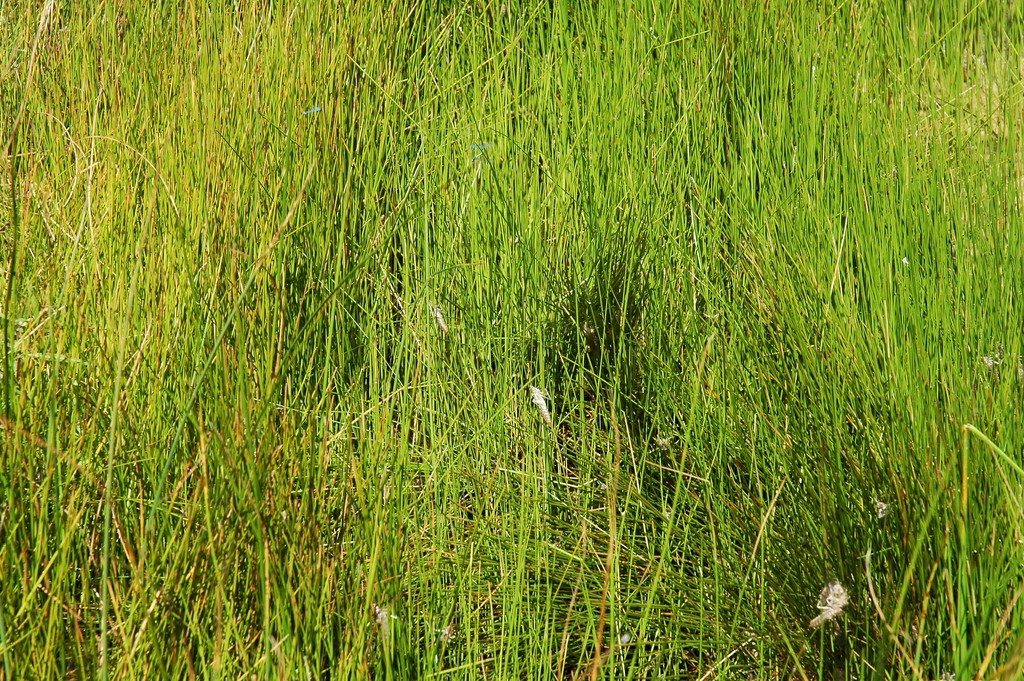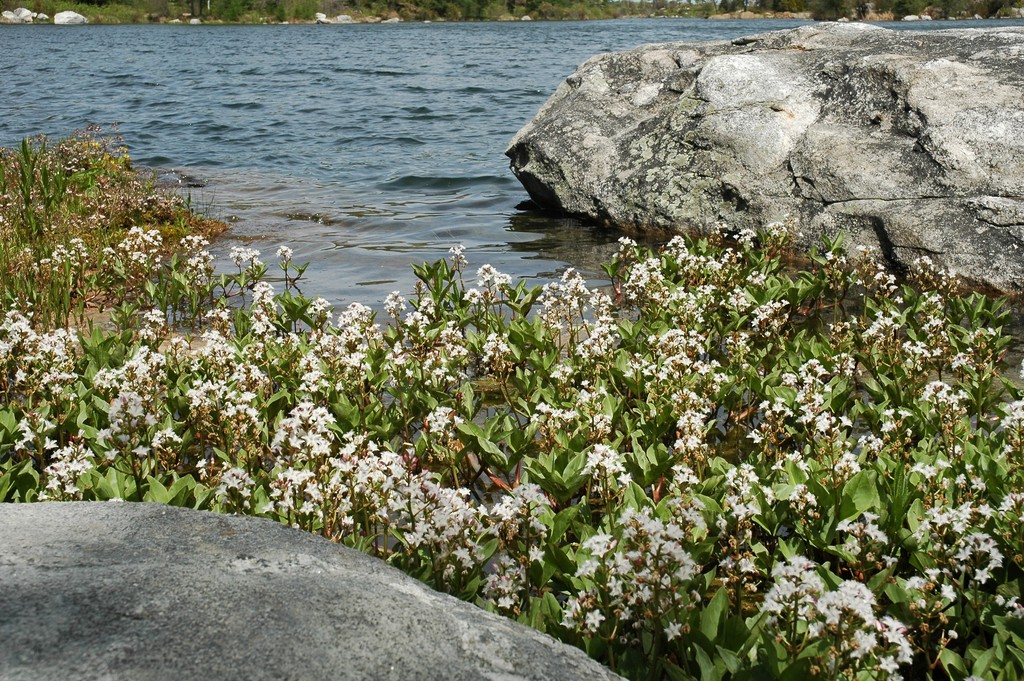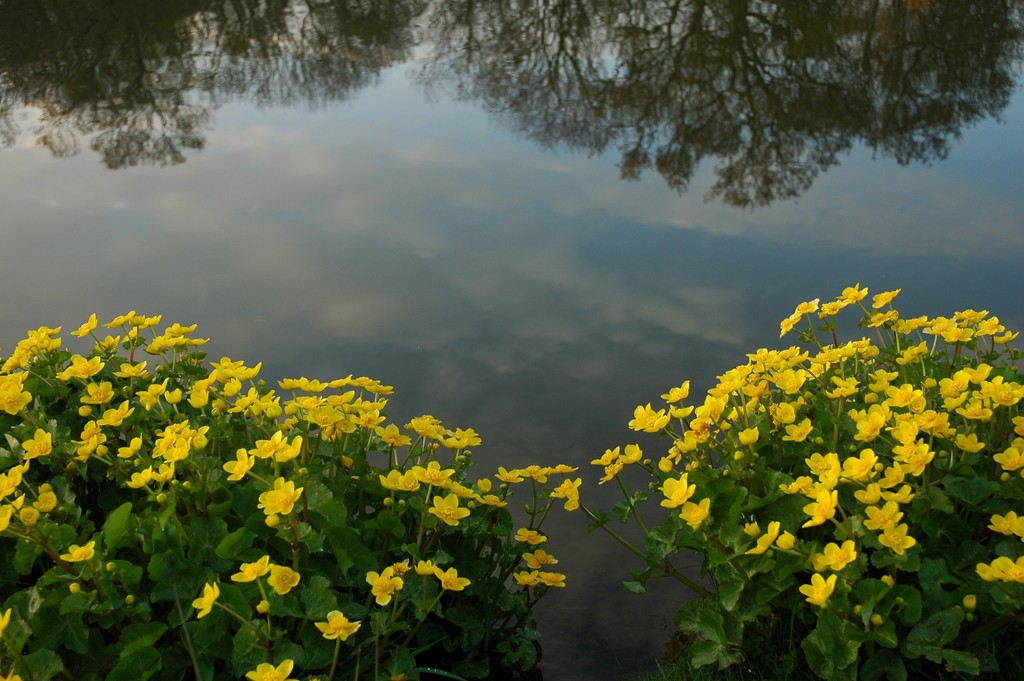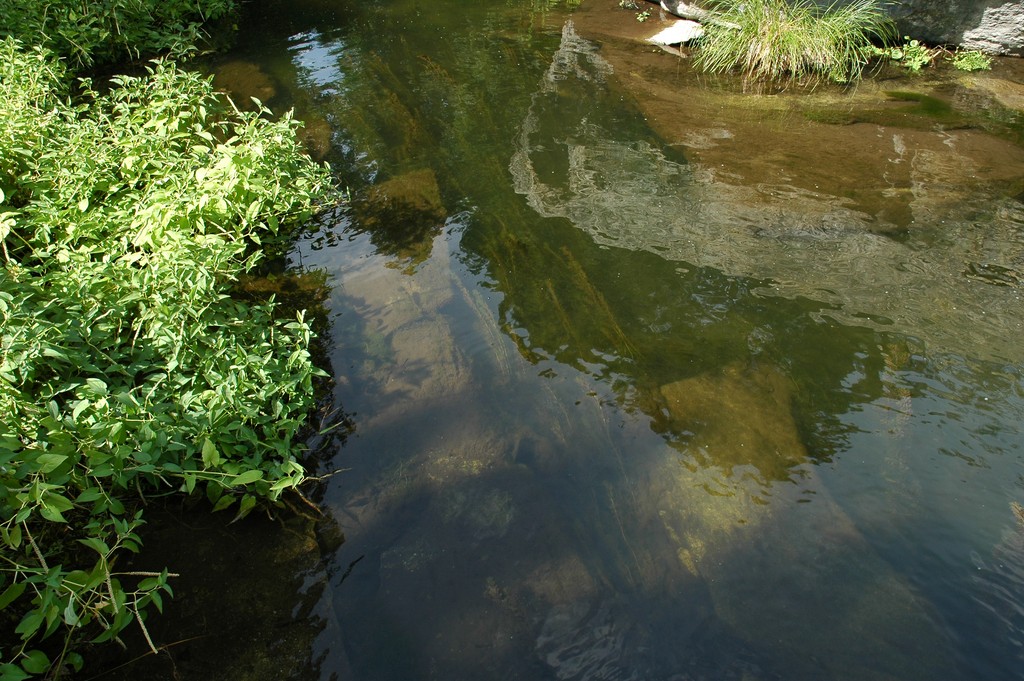Simple Transparency

Think of it: Just below the surface of our ponds and streams is a wonderful potential for beauty, an amazing opportunity to open observers’ eyes to an entire submerged “landscape” made possible by virtue of completely clear water. I like to picture it as an “underwater garden,” which is why, to me, water clarity is an essential component of my ponds and streams.
Too often, however, I run into settings in which it simply has not been a priority for the designer or installer. I’m further distressed when the subsurface views I treat as key design elements are left partially or wholly unconsidered.
I think back to my family’s trips to the seashore, where we would spend hours observing rocky tidal pools. Peering into the water and seeing a world of oceanic plants and animals at close proximity was a profound source of fascination and excitement. It is for me still – and, I believe, for most other people as well.
What I see in tide pools is a perfectly balanced, utterly natural underwater garden filled with beautiful stone colors, textures weathered by the action of the waves and tides and a plethora of pebbles and sand mixed with bits of seashell.
It is here that we may caress the smooth rock formations that have been sculpted through the eons by the motion of water. There are also countless varieties of algae known to us as seaweeds, with their spectacular leafy structures dancing and swaying with the currents and filtering and reflecting sunlight in endless symphonies of color and movement. Then there’s the enthralling spectrum of marine animal life.
All of this is why I believe that we must consider water clarity during the design and installation phases for our watergardens.
CLEAR AND CLEAN
In considering water clarity, I’ve always thought that we have much to learn from the world of aquariums, where the entire focus is the underwater environment. Here, the beauty and complexity of the scene is limited only by one’s imagination, with the rocks, plants, sands and fish displayed with an almost surreal clarity beneath the “grow” lights.
With aquariums, there’s a deliberate effort to recreate the beauty of a tide pool in the home – a goal that we as watershapers should endeavor to emulate in our exterior works. In my artificial settings, clear water is not for me an optional or secondary concern: It is one of the most intrinsic and significant of aesthetic design elements.
It is only through the presence of healthy, clear water that our interest in the underwater garden is rewarded.
| The prominent role plants play in creating and sustaining water clarity cannot be underestimated. This single pond is healthy and well-balanced and features an abundance of water-loving plants – all of which have roots that consume bountiful quantities of nutrients, help to keep algae at bay and serve as a consequence to generate crystal-clear water. |
I’m mindful of the fact that clear water is a product of healthy, balanced, natural systems, the generation of which in many respects should be the prime directive of the shapers of ponds and streams. It’s the potential of these underwater gardens that makes us strive for clarity; at the same time, it’s essential to note that these gardens themselves can become agents for generating clear water on their own.
It is in this context that we watershapers all must begin thinking about the importance of balanced biological environments – and for good reason, because there’s an amazingly complex set of symbiotic relationships at work in our ponds and streams.
Consider the ways in which rock, gravel and sand formations provide havens for beneficial bacteria, algae, sponges, crustacea and myriads of other tiny organisms. Together these form a wonderful process. Bacteria break down dead organic material into dissolved inorganic substances. Using these and other nutrients in the water (and aided by sunlight and carbon dioxide), the green plants are built, liberating in the process large quantities of oxygen.
This plant material provides the nourishment for all the aquatic creatures that eventually become food for the fish. The more varied and interesting the habitat, the richer will be the flora and fauna and the greater the beauty of and the happier the fish. And I learned early on that a happy fish is a healthy fish.
The issue of water quality is, in fact, inextricable from aesthetic elements that foster clarity: The health of both animal and plant life depend on quality water, while at the same time, quality water depends on the presence of thriving aquatic organisms. That relationship (and our understanding of it) is absolutely fundamental to the design of any system that contains life.
WILD AT HEART
In my days of running an aquatic nursery, I became quite in tune with the needs of fish. It wasn’t long before I began thinking in terms of “furnishing” bodies of water with those needs firmly in mind.
We found that those environments in which fish thrived were also the same bodies of water that had the greatest visual variety with respect to the underwater scene in addition to the most desirable water quality. These bodies of water never required attention or curative water treatment; indeed, it was not lost on me that the most beautiful underwater gardens were also maintenance-free.
In the context of raising fish and aquatic plants in man-made environments, it’s fair to say that the underwater-garden concept paid off when we transferred our understanding of natural relationships to our artificial pond and stream environments. Here, we saw that the importance of “natural balance” was even more profound.
| As a watergarden designer, I cherish the capacity of clear water to reveal underwater structures, channels, currents – a whole subsurface geography and ecology. I see the definition of of these amazing contours as a culmination of the watergardening exercise – and as a level of thoroughness to which all designers of naturalistic watershapes really should aspire. |
As with the more important aspects of watershaping, observation of nature is essential, and among the most informative models are natural streams where we see crystal-clear water flowing over beds of smoothed stones and pebbles. On becoming intimately familiar with certain streams over an extended period, I observed that the only time any cloudiness developed would be after a storm, when soils and perhaps even fertilizer were washed into the stream. Invariably, those streams cleared up very, very quickly.
I began to consider what it is that’s different about clear streams compared to those that have more turbid water. What we see in the healthier streams is a pair of important common elements:
[ ] First, there are abundant aquatic plants that cling to the edges and gravel beds of the healthy streams, with the root systems as well as the waving beards of foliage extending into the water to play key roles in water quality. These stem, leaf and root structures are home to a range of microorganisms and small creatures, including shrimp (Gammarus).You see this when you remove such a plant from a stream: It’s almost always laden with life – beneficial communities of plants and animals that absorb nutrients, feed on algae and provide food sources for larger animals such as fish. In sum, healthy streams almost always host extraordinarily dynamic and complex biological communities.
[ ] Second, and utterly inseparable from the animal and plant life, is the presence of beds of pebbles and rocks of various sizes. Essentially, this enables the entire streambed to serve as its own biological filter. Again, when you pick up a single pebble and look at its underside, you might see splotches formed by bacterial colonies – and that’s just one pebble among millions.CLEAR ASSISTS
A stream also gives us a wonderful opportunity to use the mechanical energy of moving water to its own benefit.
In the large streams I’ve constructed, for example, not only will we place gravel along the entire streambed, but we’ll also create banks of gravel (averaging 3/4 inches in size) over and through which the water will flow. In almost all of these situations, I’ve been able to guarantee that, within a week or so, the water will be completely clear and largely self-sustaining, almost always without the use of supplemental filtration or water-treatment technology.
That said, it is extremely important to recognize just how useful filtration technology for ponds and streams can be. In my view, the development of mechanical biofiltration units (along with ultraviolet and ozone water-treatment systems) has been absolutely crucial to the development of the stream-and-pond market: These systems have enabled tens of thousands of consumers to enjoy beautiful, clear water in their backyard stream and/or pond systems.
These biofiltration components and water-treatment systems are so important largely because, at a given level of the industry, a great many people are not patient enough to develop systems that are self-sustaining. In many situations, in fact, consumers will do things to a point of excess, loading relatively small bodies of water with overly high concentrations of fish life that foster excessive nutrient levels.
| In these cases, water-friendly plants have been used in creating bog-like ecologies in which the plants send copious quantities of exploratory roots into the pond to absorb nutrients – and also serve to filter all the water that flows through and around them, either sideways or down through the planting bed. |
This is an important point: The presence of plants and animals does not alone ensure water quality; in fact, those elements must be present in proper proportion to the given body of water. Situations in which, say, a dozen fish would be perfect are undermined when people populate the water with, say, a hundred fish. In those situations, nature cannot cope with the biological load and will need help: In these cases, mechanical biofiltration (supplemented or not by water treatment) is the only path to water clarity.
In nature, we seldom see these overstocked bodies of water: Fish will begin to eat their own eggs, or their mortality rate will rise until the “system” naturally achieves balance. In man-made applications that are re-circulated and contained, overstocking creates hazardous conditions that can result in the wasting of tremendous amounts of money on the one hand and in poor water conditions on the other. I have always maintained that it is far better to have a few fish you can see than lots of fish you can’t.
This much is absolutely clear: Many otherwise beautiful underwater scenes are rendered useless by cloudy water caused by overstocking.
SELF-SUFFICIENT
Although I am an enthusiastic advocate of “outboard” filtration and treatment systems, through the years I’ve come to believe that, ultimately, any stream or pond system can be made to be self-sustaining provided you do the right things. In fact, when I started in the business, one couldn’t even buy a pond filter, so the only means for generating clear water was to learn to work with nature to create balanced environments.
Perhaps my favorite approach to filtration involves the use of under-drain manifold systems that effectively make a body of water act as its own biological filter. It’s an elegant approach: Perforated plumbing draws a column of water through a bed of gravel, so the biological filtering action that occurs within an outboard filter takes place instead in the floor of a pond.
While it is preferable to make the filter pond separate from the one containing the fish, there is no reason why this filtering pond should not be a feature of great beauty: There is no limit to the size of these systems, and in conjunction with suitable plantings, they can make a system virtually maintenance-free.
The first time I deployed this approach was in a large pond for a customer who maintained a fantastic collection of valuable Koi, many in excess of 18 inches in length – truly amazing specimens.
I established a pond especially for the Koi that would provide them with a comfortable home and clear water so they could easily be seen. At a slightly higher elevation, I constructed another pond of just one-third the size that contained perforated pipes set up in a herringbone pattern and encased in a bed of gravel. Those runs fed a large manifold that in turn connected to a clear-water chamber – a sump that welled up and spilled over a waterfall into the Koi pond.
Some eight years after I installed the system, I had occasion to talk to the homeowner and ask him how the system was working. Although I knew the filter should be reliable and easy to maintain, I admit to being somewhat amazed when he told me that in the entire time since the pond had been installed, he hadn’t touched it at all. It had been completely self-sustaining.
I had similar success early on with a massive pond used for raising trout – very sensitive to water quality. Here, I installed a filtration bed that was some 60 feet across, and it too ran beautifully for years, maintaining tremendous water quality. Based on these and other experiences, I became very comfortable with this form of filtration and have since used it on a great many projects.
Through experience and experimentation, I found that it was only the top few inches of gravel that contained the vast majority of anaerobic bacteria and creatures that provided the filtering effects. Thus, surface area is far more important to the success of the system than is depth, which is why I always try to spread these beds out rather than worry about making them deep.
ROOT OF THE MATTER
Years later, I began working with what some describe as “bog filters” in which I would establish shallow areas with submerged drainage – the difference being that the gravel beds in these bogs were planted with reeds and other forms of emergent plants. These systems have the added benefit of using the plants’ root structures to absorb nutrients.
I came upon this approach in the 1970s while working with plants set on pond edges in planting baskets: I observed that emergent plantings would quickly use up the soil in their baskets and would send out fine networks of adventitious roots into the pond in a quest for nutrients.
| The effective encouragement of water clarity pays off in innumerable ways, both aesthetic and practical. On the beauty side, it sets the watershape up to reveal its underwater structures with brilliant clarity – and serves as a pristine reflective surface for surrounding plants, clouds and skies. On the functional side, it sets up a watergarden for flawless, long-term, low-maintenance performance – the kind of achievement that makes the homeowner believe they are actually in the presence of a natural, self-sustaining water system. |
It became obvious to me that these root systems were playing a key role in water quality, so I decided to enhance this natural effect. I did so by planting bog areas and drawing the water through the resulting mat of fine root hairs with the suction provided by a network of buried drainage pipes.
To my mind, this is a perfect marriage of nature and artificial systems: They always seem to work out effectively, and creating these configurations is really quite easy to do. I’ve found that pretty much any type of emergent or marsh plants will work – provided, of course, that sufficient quantities are used.
I’ve had a number of discussions with other watergardeners about this process and find that there are two distinct approaches – one in which the water flows downward into the gravel and the root systems, the other in which the water wells up. (It is also possible to run the water sideways – that is, down an inclined shelf.)
My preference has always been to design the filter so water is drawn down into the bog instead of the reverse. Water welling up through sand creates quicksand, and I always worry that upward flows might lead to instability and the return of dead leaves and rotting detritus into the pond. It’s also been my observation that things work well trickling either downwards (or sideways).
THE OXYGEN FACTOR
As has always been the case with outboard filtration units, aeration systems of any kind have been a huge help to pond designers and installers across a wide range of applications. I commend aerator manufacturers for giving the pond industry an extremely helpful tool, because the dissolved oxygen these devices introduce to ponds is crucial for the decomposition of organic compounds that make their way into the water.
|
The Myth of Flow There’s one area in which the casual observation of nature can lead to misconception, and it has to do with water circulation and flow rate. Indeed, watching a natural stream can lead you to the false conclusion that water needs to flow vigorously or rapidly to be clear. Although flow that creates action over waterfalls and rocks and through gravel beds is indeed useful in many circumstances, it is not essential. In a perfectly quiescent pond, for example, the wind, the temperature differential in the upper layers and the movement of fish will create circulation and chemical exchanges at the surface that are more than adequate. To me, this discussion boils down to the self-evident fact that we do not see bodies of water where one part is clear next to another that is not. Other than in areas influenced by some sort of recent or repeated disturbance, water quality tends to be mostly uniform within natural systems. (Deep lakes and ponds are an exception where annual temperature stratification occurs.) I’ve had some vigorous (and invigorating) debates with various people on this issue. In one project, for example, I recall working with an engineering company that wanted to place skimmers all around the edges of a medium-size pond – something like a dozen skimmers in all. Not only did this force me to figure out ways to disguise all of those skimmers, but I argued it was completely unnecessary in that the flow required to generate biological filtration and beneficial interaction among plants, animals and water was in fact quite minimal. Again, you never see a pond where you can see the bottom in one part but not another. Water by its very nature mixes: It is, after all, a fluid of minimal viscosity. In my work, I’ve found that a single source of suction and a single source of return flow are almost always sufficient. Water quality is like smoke in a room: If it’s in one corner of the space, it’s going to make its way to the others as well. If anything, too much flow can actually be a problem: In its headlong rush, there might not be adequate contact time between the water and various biological elements to allow for the subtle chemical processes that must transpire. –A.A.W. |
Oxygen is indeed a key player in nature, where the game is always about keeping everything in balance. As with separate filtration systems, I use aerators only when absolutely necessary, mainly because I’ve found that the oxygen released by aquatic plants is usually adequate. But I see their great value just the same.
There are situations, however, where it’s essential to give the natural processes of oxidation and decomposition assistance by using an aerator. In ponds that have a high oxygen demand as a result of excessive decaying organic matter or an imbalance in the ratio of plants to fish, for example, plant material alone may not do the trick – partly because plants don’t produce oxygen at night.
Ponds and streams on golf courses are commonly fitted with aerators because water in these settings is absolutely laden with plant nutrients and managing dissolved oxygen levels is critical. These are situations in which you might find countless acres of constantly fertilized turf draining into ponds or streams.
With limited space as well there is almost no way to develop an ecosystem that can handle such a load – typically rich mixes of sulphate, phosphate, nitrate and potassium – which is why these waterways are so often subject to spectacular algae blooms. While such richness might be useful in fish farming, unsightly rafts of filamentous algae can develop in waters that aren’t managed properly.
Aerators also prove their worth in fish ponds subjected to long spells of hot weather that can result in high water temperatures. The higher the water’s temperature, the less oxygen a pond or stream can hold – a situation that can lead to oxygen depletion and in which aerators will help to keep the water well oxygenated.
Most ponds that I’ve seen with severe water-quality problems also happen to be those that lack adequate amounts of aquatic and emergent plants that are crucial for both the absorption of nutrients and the production of oxygen. In these situations, nature doesn’t have a chance to find its own balance: A well-considered planting program will help and, if necessary, can be augmented by aeration.
CLEAR EYES
All ponds and streams are different, of course, with tremendous variations with respect to size, plant material, animal life, surrounding environmental conditions and more, thus making it difficult to generalize and make recommendations about what might or might not be the best way to achieve superior water quality. Quite simply, every project must be considered on its own terms: What might be a perfect solution for one situation may well not be the best for another.
In my work, trial and error and large doses of observation have been the best teachers. The key is to pay attention and determine the true nature of the relationships among various elements in the system, be they plants, animals, filtration approach, water volume and many other factors – and to monitor the results carefully. Happily, we can start sure in the knowledge that plants and animals have complex symbiotic relationships, that rocks and gravel can play major roles, and that all bodies of water require oxygen in order to process organic matter.
How exactly you achieve a balance among all the elements of a watergarden is always going to be a little bit different. When you understand the basic, natural dynamics in play, then you can begin to control the watershaping process so that the waters are as clear as a quality gin in a Waterford glass goblet.
Anthony Archer Wills is a landscape artist, master watergardener and author based in Copake Falls, N.Y. Growing up close to a lake on his parents’ farm in southern England, he was raised with a deep appreciation for water and nature – a respect he developed further at Summerfield’s School, a campus abundant in springs, streams and ponds. He began his own aquatic nursery and pond-construction business in the early 1960s,work that resulted in the development of new approaches to the construction of ponds and streams using concrete and flexible liners. The Agricultural Training Board and British Association of Landscape Industries subsequently invited him to train landscape companies in techniques that are now included in textbooks and used throughout the world. Archer Wills tackles projects around the world and has taught regularly at Chelsea Physic Garden, Inchbald School of Design, Plumpton College and Kew Gardens. He has also lectured at the New York Botanical Garden and at the universities of Miami, Cambridge, York and Durham as well as for the Association of Professional Landscape Designers and the Philosophical Society.










